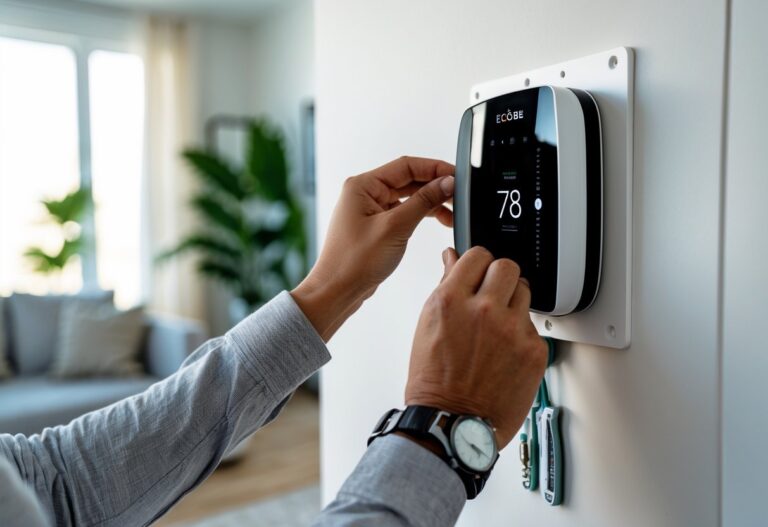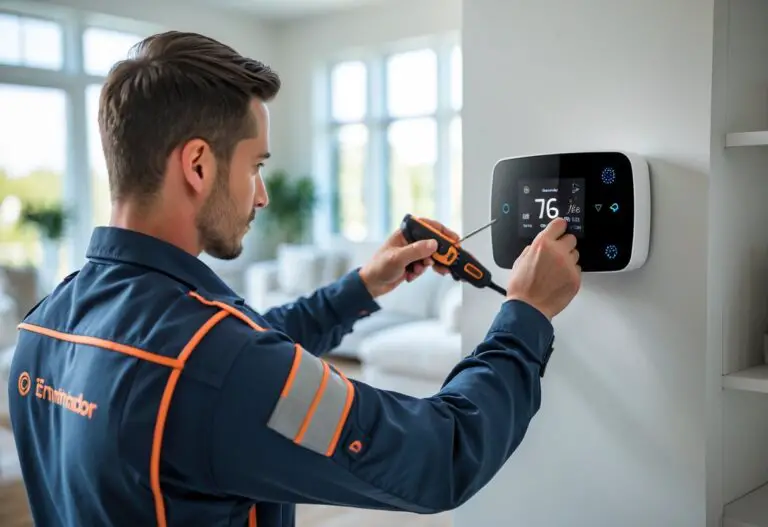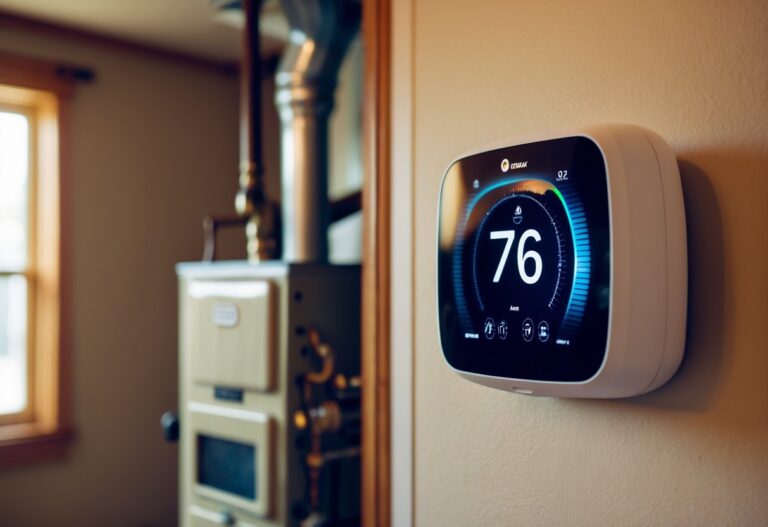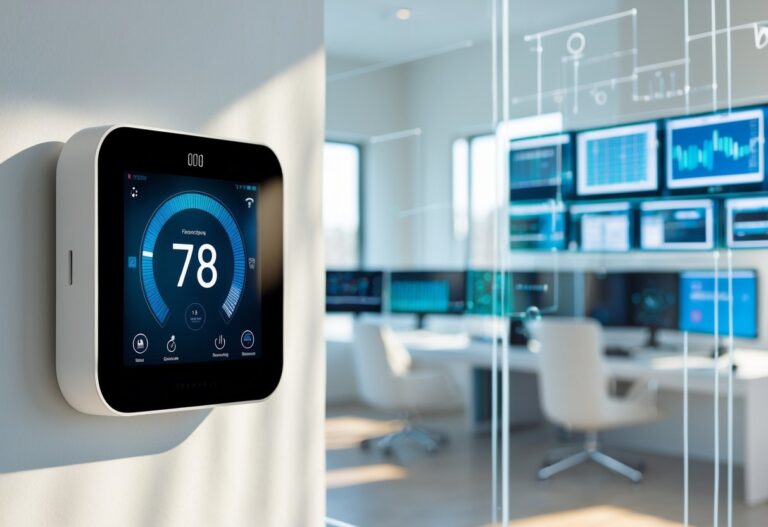Are you thinking about upgrading your home’s heating and cooling system with a smart thermostat? The average smart thermostat installation cost, including both the device and professional installation, ranges from $200 to $500. These costs can change based on the brand, features, and how complex the wiring is in your home.
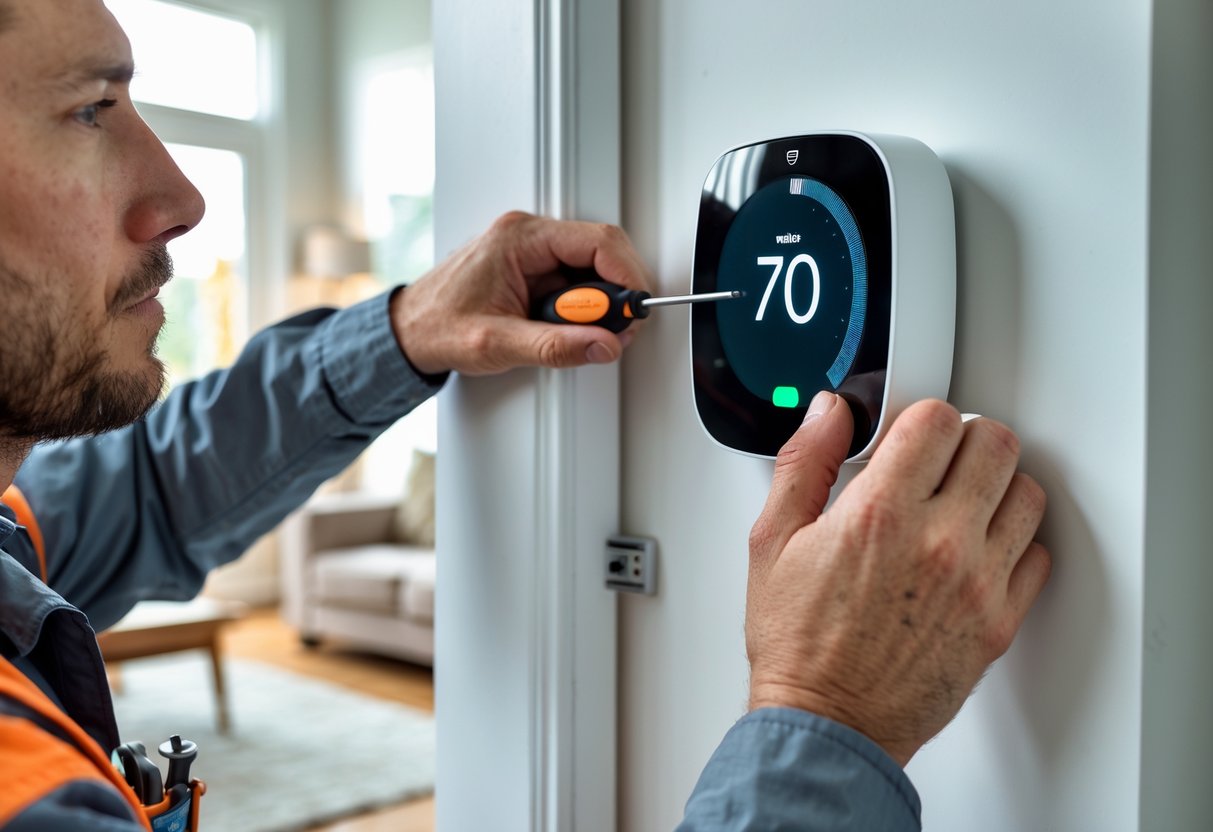
Choosing a smart thermostat means you will not only enjoy better temperature control but might also lower your energy bills over time. New smart thermostats can be controlled from your phone and may have advanced features like scheduling and voice commands, but these can affect installation costs.
Key Takeaways
- Average smart thermostat installation costs $200 to $500
- Price depends on brand, features, and home wiring complexity
- Choosing the right model can increase your savings and comfort
Average Smart Thermostat Installation Cost
Smart thermostat installation costs can vary depending on the brand, features, and professional labor required for setup in your home. Understanding the average prices and ranges can help you plan your budget and choose the right thermostat for your needs.
National Average Cost
In the United States, the national average cost to install a smart thermostat is about $350. This figure includes both the price of the thermostat and the labor required for installation.
Labor costs are an important part of the overall amount you pay. Hiring a professional usually costs between $100 and $250, depending on your location and the complexity of your HVAC system. DIY installation can save you on labor, but it may not be suitable for all homes, especially if additional wiring is needed.
Here is a table showing common prices:
| Item | Typical Cost |
|---|---|
| Thermostat (Basic Model) | $70 – $150 |
| Thermostat (Advanced) | $200 – $800 |
| Professional Labor | $100 – $250 |
| Total (Installed) | $200 – $500 |
Prices can be higher if you choose a premium model with advanced features, or if your system needs extra work during installation.
Average Cost Range
Most homeowners pay between $200 and $500 for full smart thermostat installation. The range covers both budget options and high-end models with extra features like voice control and occupancy sensors.
The main factors affecting the cost are the price of the thermostat itself and the difficulty of the installation. For example, replacing a simple existing thermostat may be cheaper, while installing a smart model where new wiring is necessary will cost more.
If you only need to replace an old unit with a new one of similar type, you may be closer to the low end. More complex jobs, including upgrades to wiring or adapting to different systems, can push the price upwards.
Some high-end thermostats can cost over $800 just for the device. Adding labor brings the total for premium setups to as much as $1,000. Always compare several brands and check if your HVAC system is compatible before choosing a model.
Key Factors Affecting Smart Thermostat Installation Cost
Many details can change how much you pay to install a smart thermostat. The type of thermostat you pick, how hard it is to install, the wiring in your home, and any extra features all play a part in your final cost.
Type of Thermostat
The price of smart thermostats can range from around $50 for basic models to $800 for high-end versions. Choosing between brands like Nest, Ecobee, or Honeywell makes a big difference in what you spend.
Basic units may only control heating and cooling, while more advanced models offer extra sensors, touchscreens, or voice control.
If you want features like app control, learning ability, or remote sensors, plan on paying more. The smart thermostat you pick will strongly affect both the device cost and, in some cases, installation labor if setup is more complex.
Labor and Installation Complexity
Labor costs for professional installation are often in the $200–$500 range, and can go higher for tricky jobs. If you have an older system or want the unit placed in a hard-to-reach spot, technicians may charge more.
Some homes have complicated heating or cooling setups. Dual-fuel systems, zoning, or multiple thermostats can add to the price. Installers may also charge extra if your system needs more time due to unusual wiring or extra steps.
A simple, direct installation will almost always cost less than a job that takes longer or requires special skills.
Wiring and Compatibility
Your home’s wiring is one of the biggest factors in installation cost. Most smart thermostats need a common wire (called a C-wire) for power. If your system doesn’t have one, technicians may need to run new wiring.
Adding a C-wire can increase the labor cost by $100 to $400, depending on your home’s layout.
If your heating and cooling system is old or has special controls, compatibility can be a problem. Make sure the smart thermostat you choose works with your system. You may need adapters or extra electrical work, both of which add to your final bill.
Additional Accessories and Features
Some installations need extra hardware such as sensors, mounting plates, or power extenders, each with its own cost.
Features like room sensors or humidity controls often require extra setup. Some brands sell accessory kits for better control or energy tracking, increasing both the device and install labor cost.
You might also want wall repair or paint touch-ups after removal of an old thermostat. Budgeting for these additional costs helps you avoid surprises when your installation is finished.
Comparison of Smart Thermostat Brands and Models
Choosing a smart thermostat involves more than just price. You’ll want to consider features, compatibility, and how each model fits your home and lifestyle.
Popular Brands: Nest, Honeywell, Ecobee, Hive, Trane, Carrier
Popular brands like Nest, Honeywell, Ecobee, Hive, Trane, and Carrier offer a wide range of smart thermostats. Each brand has unique features and costs. Nest is known for its simple design and learning features. Ecobee offers extra room sensors for better comfort across your home.
Honeywell has many options, from simple smart thermostats to advanced models. Trane and Carrier are often chosen for their compatibility with HVAC systems and reliability. Hive is more common in the UK but offers smart features similar to other brands.
| Brand | Model Example | Starting Cost | Special Features | Max Sensors |
|---|---|---|---|---|
| Nest | Nest Learning | $100 | Learns schedule, voice control | 8 |
| Ecobee | Ecobee SmartThermostat | $150 | Extra room sensors, Alexa built-in | 32 |
| Honeywell | T9/T10 Pro | $120 | Geofencing, app control | 20 |
| Hive | Hive Active Heating | $120 | Integration with Hive ecosystem | 6 |
| Trane | ComfortLink II XL | $250 | Full-color touchscreen, HVAC sync | N/A |
| Carrier | Infinity Touch | $200 | Advanced scheduling, app, weather | N/A |
Smart Features and Voice Assistant Integration
Most smart thermostats now support smart home devices and voice assistants. Popular options like Amazon Alexa and Google Assistant are often included. Ecobee even comes with Alexa built-in, so you can control it by voice without another device. Nest is compatible with Google Assistant and can also link with Alexa.
Honeywell thermostats usually support both Alexa and Google Assistant, plus Apple HomeKit in some models. Carrier and Trane often work with their own apps but can connect to popular smart home platforms. Apple HomeKit support is important if you use Apple devices, as not all thermostats have it.
These integrations let you control your temperature with simple voice commands or connect your thermostat with other smart home routines. This means you can set schedules, change settings remotely, or link the thermostat to other devices in your house.
Programmable vs Manual and Non-Programmable Thermostats
There are three main kinds of thermostats you’ll see: programmable, manual, and non-programmable models. Programmable thermostats let you set schedules, so you don’t have to adjust the temperature each day. They can help save energy by only running heating or cooling when you need it.
Electronic programmable thermostats are the most common smart choice. You can control these with an app and sometimes set them from anywhere. Manual thermostats must be changed by hand and don’t support schedules. These are less expensive but also less convenient.
Electronic non-programmable thermostats offer digital controls but no advanced scheduling. Line-voltage thermostats are usually used for electric heaters, while boiler thermostats are designed for specific systems. You’ll want to choose the type that fits your home’s heating and cooling system for best results.
Smart Thermostat Installation: Value, Savings, and Considerations
Installing a smart thermostat means looking at costs, savings, and benefits for your household. It’s important to compare installation methods, check potential energy savings, and think about how new technology works with your existing HVAC system and budget.
Professional vs DIY Installation
You can choose between professional installation or doing it yourself. Professional installation usually costs between $100 and $500, depending on the type of smart thermostat, wiring complexity, and your home’s HVAC system. Some installers provide free estimates, so it’s smart to compare prices before making a decision.
DIY installation kits cost less, ranging from $70 to $300 for the device. Brands include step-by-step instructions and sometimes online support. Still, improper installation can cause issues with your HVAC system, lower energy efficiency, or even void your warranty.
Professional installation is worth considering if your setup is complicated, includes multi-zone HVAC systems, or you are replacing an older thermostat. A licensed installer can also help you select the right model and ensure the system works correctly from the start.
Potential Energy and Cost Savings
A smart thermostat’s main appeal is lowering your energy bills. By learning your routines, using geofencing, and providing detailed energy reports, these devices help you cut down on unnecessary heating and cooling. Energy Star certified models may improve energy efficiency even more.
Estimates suggest you might save up to 10-20% on your heating and cooling costs, though the exact amount depends on your energy consumption, thermostat model, and habits. Some utility companies offer rebates for upgrading to a smart thermostat, further increasing your potential savings.
Monitoring energy consumption gives you better control over your energy use. Over time, these savings help offset the initial thermostat installation cost.
Home Automation and Integration with HVAC Systems
Smart thermostats fit into home automation systems and work with many HVAC setups. Features like remote control from your smartphone, voice command compatibility, and temperature control for multiple zones add convenience.
If your home uses a multi-zone HVAC system, some thermostats allow you to manage temperature in each zone separately for higher energy savings and comfort. Integration with other smart devices, such as sensors or assistants, can offer even more control over your heating and cooling systems.
Not every thermostat is compatible with every HVAC system. Always check manufacturer requirements before purchasing a new thermostat or replacing an old one. Additional accessories might be needed for complex setups.
Warranty, ROI, and Long-Term Value
When buying a smart thermostat, consider the manufacturer warranty and support. Most leading brands offer warranties ranging from 1 to 5 years. Professional installation may extend or protect the warranty, while DIY installation has the risk of accidental damage.
Return on investment (ROI) varies, but many homeowners see payback within a few years, especially when leveraging rebates or sales and discounts. Tracking your energy reports will help show your actual utility bill reductions.
Long-term value comes not just from savings, but from improvements in comfort, easy access through home automation, and fewer manual adjustments. Maintenance is often simpler, making smart thermostat installation a practical upgrade for home improvement.
